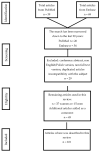The Role of Arachidonic and Linoleic Acid Derivatives in Pathological Pregnancies and the Human Reproduction Process
- PMID: 33348841
- PMCID: PMC7766587
- DOI: 10.3390/ijms21249628
The Role of Arachidonic and Linoleic Acid Derivatives in Pathological Pregnancies and the Human Reproduction Process
Abstract
The aim of the available literature review was to focus on the role of the proinflammatory mediators of AA and LA derivatives in pathological conditions related to reproduction and pregnancy. Arachidonic (AA) and linoleic acid (LA) derivatives play important roles in human fertility and the course of pathological pregnancies. Recent studies have demonstrated that uncontrolled inflammation has a significant impact on reproduction, spermatogenesis, endometriosis, polycystic ovary syndrome (PCOS) genesis, implantation, pregnancy and labor. In addition, cyclooxygenase-mediated prostaglandins and AA metabolite levels are higher in women's ovarian tissue when suffering from PCOS. It has been demonstrated that abnormal cyclooxygenase-2 (COX-2) levels are associated with ovulation failure, infertility, and implantation disorders and the increase in 9-HODE/13-HODE was a feature recognized in PCOS patients. Maintaining inflammation without neutrophil participation allows pregnant women to tolerate the fetus, while excessive inflammatory activation may lead to miscarriages and other pathological complications in pregnancies. Additionally AA and LA derivatives play an important role in pregnancy pathologies, e.g., gestational diabetes mellitus, preeclampsia (PE), and fetal growth, among others. The pathogenesis of PE and other pathological states in pregnancy involving eicosanoids have not been fully identified. A significant expression of 15-LOX-1,2 was found in women with PE, leading to an increase in the synthesis of AA and LA derivatives, such as hydroxyeicozatetraenoic acids (HETE) and hydroxyoctadecadiene acids (HODE). Synthesis of the metabolites 5-, 8-, 12-, and 15-HETE increased in the placenta, while 20-HETE increased only in umbilical cord blood in women with preeclampsia compared to normal pregnancies. In obese women with gestational diabetes mellitus (GDM) an increase in epoxygenase products in the cytochrome P450 (CYP) and the level of 20-HETE associated with the occurrence of insulin resistance (IR) were found. In addition, 12- and 20-HETE levels were associated with arterial vasoconstriction and epoxyeicosatrienoic acids (EETs) with arterial vasodilatation and uterine relaxation. Furthermore, higher levels of 5- and 15-HETE were associated with premature labor. By analyzing the influence of free fatty acids (FFA) and their derivatives on male reproduction, it was found that an increase in the AA in semen reduces its amount and the ratio of omega-6 to omega-3 fatty acids showed higher values in infertile men compared to the fertile control group. There are several studies on the role of HETE/HODE in relation to male fertility. 15-Hydroperoxyeicosatetraenoic acid may affect the integrity of the membrane and sperm function. Moreover, the incubation of sperm with physiologically low levels of prostaglandins (PGE2/PGF2α) improves the functionality of human sperm. Undoubtedly, these problems are still insufficiently understood and require further research. However, HETE and HODE could serve as predictive and diagnostic biomarkers for pregnancy pathologies (especially in women with risk factors for overweight and obesity). Such knowledge may be helpful in finding new treatment strategies for infertility and the course of high-risk pregnancies.
Keywords: HETE; HODE; arachidonic acid; endometriosis; gestational diabetes mellitus; inflammation; polycystic ovarian syndrome; preeclampsia; pregnancy disorders.
Conflict of interest statement
The authors declare that they have no conflict of interest.
Figures




Similar articles
-
Inflammation with the participation of arachidonic (AA) and linoleic acid (LA) derivatives (HETEs and HODEs) is necessary in the course of a normal reproductive cycle and pregnancy.J Reprod Immunol. 2020 Sep;141:103177. doi: 10.1016/j.jri.2020.103177. Epub 2020 Jul 7. J Reprod Immunol. 2020. PMID: 32659532 Review.
-
Role of cytochrome P450-dependent arachidonic acid metabolites in liver physiology and pathophysiology.Prostaglandins Other Lipid Mediat. 2003 Oct;72(1-2):51-71. doi: 10.1016/s1098-8823(03)00077-7. Prostaglandins Other Lipid Mediat. 2003. PMID: 14626496 Review.
-
Cytochromes P450 with bisallylic hydroxylation activity on arachidonic and linoleic acids studied with human recombinant enzymes and with human and rat liver microsomes.J Pharmacol Exp Ther. 1998 Jan;284(1):51-60. J Pharmacol Exp Ther. 1998. PMID: 9435160
-
Relationship of omega-3 and omega-6 fatty acids with semen characteristics, and anti-oxidant status of seminal plasma: a comparison between fertile and infertile men.Clin Nutr. 2010 Feb;29(1):100-5. doi: 10.1016/j.clnu.2009.07.008. Epub 2009 Aug 8. Clin Nutr. 2010. PMID: 19666200
-
Longitudinal profiles of plasma eicosanoids during pregnancy and size for gestational age at delivery: A nested case-control study.PLoS Med. 2020 Aug 14;17(8):e1003271. doi: 10.1371/journal.pmed.1003271. eCollection 2020 Aug. PLoS Med. 2020. PMID: 32797061 Free PMC article.
Cited by
-
Birth Weight and Early Postnatal Outcomes: Association with the Cord Blood Lipidome.Nutrients. 2022 Sep 12;14(18):3760. doi: 10.3390/nu14183760. Nutrients. 2022. PMID: 36145136 Free PMC article.
-
Mass Spectrometry-Based Metabolomics Investigation on Two Different Seaweeds Under Arsenic Exposure.Foods. 2024 Dec 16;13(24):4055. doi: 10.3390/foods13244055. Foods. 2024. PMID: 39766997 Free PMC article.
-
Metabolomic analysis of follicular fluid from women with Hashimoto thyroiditis.Sci Rep. 2023 Aug 2;13(1):12497. doi: 10.1038/s41598-023-39514-7. Sci Rep. 2023. PMID: 37532758 Free PMC article.
-
Fatty Acid Metabolism Disruptions: A Subtle yet Critical Factor in Adverse Pregnancy Outcomes.Int J Biol Sci. 2024 Nov 4;20(15):6018-6037. doi: 10.7150/ijbs.103404. eCollection 2024. Int J Biol Sci. 2024. PMID: 39664564 Free PMC article. Review.
-
Tracing the Lipid Fingerprints of Preeclampsia.Reprod Sci. 2025 Jan;32(1):52-63. doi: 10.1007/s43032-024-01731-4. Epub 2024 Oct 30. Reprod Sci. 2025. PMID: 39476288 Review.
References
-
- Kikut J., Komorniak N., Ziętek M., Palma J., Szczuko M. Inflammation with the participation of arachidonic (AA) and linoleic acid (LA) derivatives (HETEs and HODEs) is necessary in the course of a normal reproductive cycle and pregnancy. J. Reprod. Immunol. 2020;141:103177. doi: 10.1016/j.jri.2020.103177. - DOI - PubMed
Publication types
MeSH terms
Substances
Grants and funding
LinkOut - more resources
Full Text Sources
Medical
Research Materials

